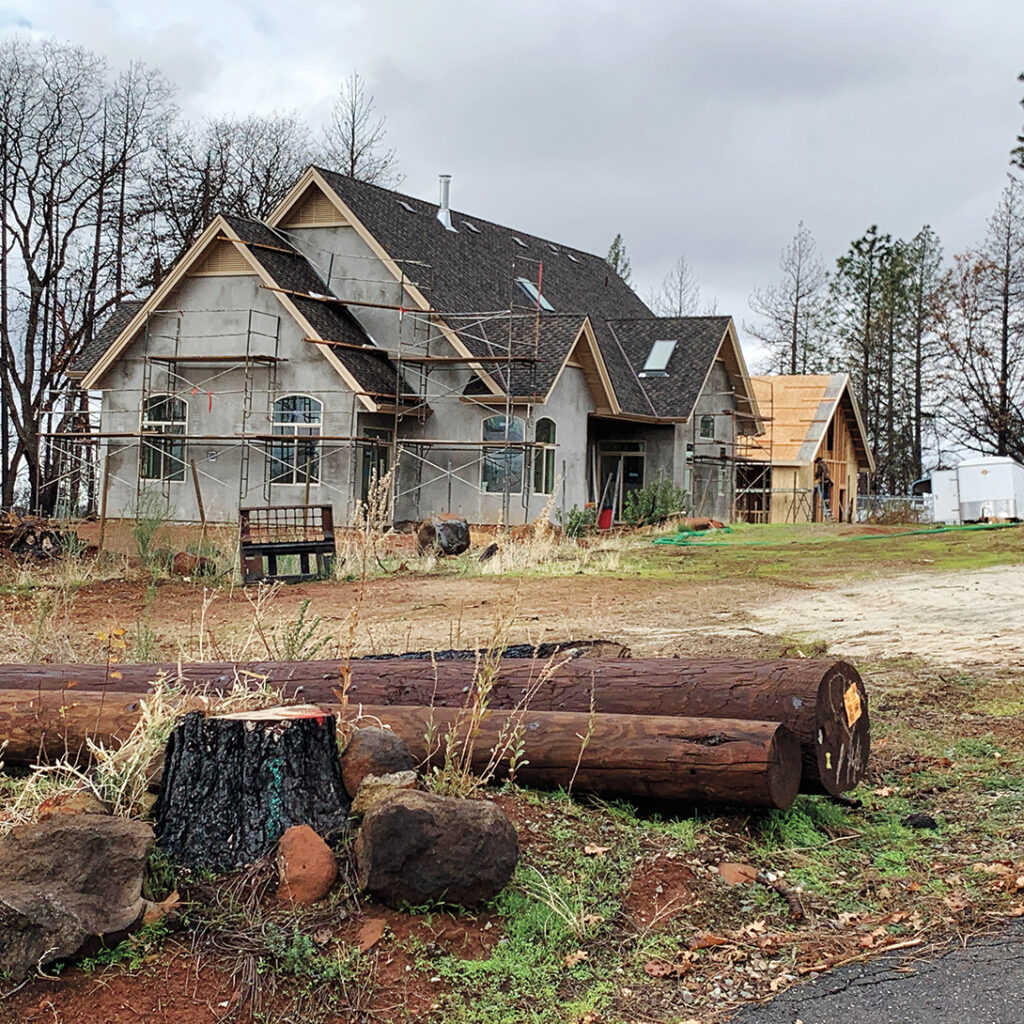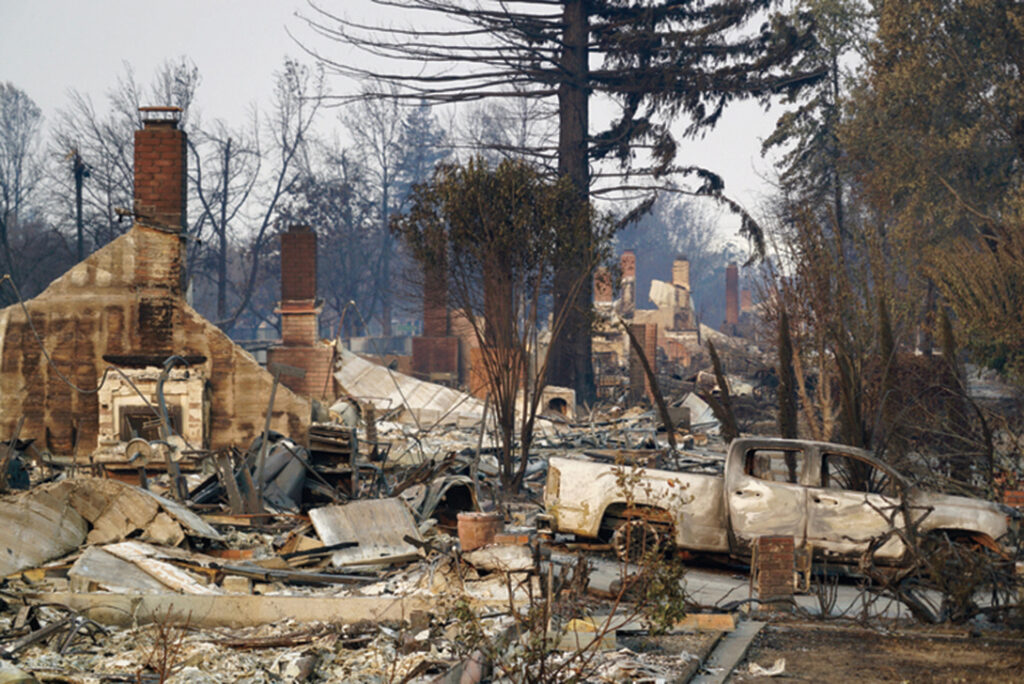Dealing with Future Wildfires: New North Bay Organizations Helping to Prepare
Rincon Valley firefighters rest in the archway and against the fireplace of a home on Wikiup Drive in Santa Rosa after the Tubbs firestorm swept through Oct. 8 and 9. These firefighters were first on the scene and had been on the job for four days when these photos were taken Oct. 12.
ON OCTOBER 8, 2017, Napa, Sonoma and Lake counties entered what has ominously been deemed “the new normal.” In dealing with the aftermath of the Tubbs Fire — one of eight wildfires to burn simultaneously within California that fall — residents of Santa Rosa and surrounding areas got a crash course in the sobering reality of the devastation such disasters can leave behind. The following year, the Camp Fire would ignite in Butte County, earning the dubious distinction of being the deadliest and most destructive wildfire in California history. As the state faces the ramifications of a perennial wildfire season, many are also looking at ongoing recovery efforts in areas affected by the Tubbs Fire to figure out what their own first steps in a crisis should be.
That’s where organizations like Rebuild North Bay Foundation come in. Founded by Sonoma developer and investor Darius Anderson, RNBF has become a resource for communities contending with their own disasters. Though Anderson left the group’s board at the start of 2019, its efforts have continued under director Jennifer Gray Thompson. Charles Brooks, director of the Rebuild Paradise Foundation, says Thompson’s offer of help after the town of Paradise’s devastating fire last fall has led to a lasting friendship. “Jennifer jokes that I’m her ‘Rebuild’ brother and I joke that she’s my ‘Rebuild’ sister,” Brooks says, “because we are. We are so closely connected, but we also forged a friendship and a bond.”
Built around a model meant to unify public, private and nonprofit sectors for a streamlined disaster recovery process, RNBF is one of a large network of new organizations that sprang from the ashes of the Tubbs and other wildfires and now provides information for areas in the midst of a disaster. They include Nuestra Comunidad, founded by 911 emergency dispatcher Alma Bowen, offering outreach and CPR training to non-English speakers and senior citizens.
“Alma is actually going to save lives,” Thompson says. “She quit her job and she started a nonprofit.” Another outfit Thompson speaks highly of is United Policyholders. Guided by director Amy Bach, the organization has put boots on the ground in seemingly every new wildfire recovery effort across California to help with the difficult task of getting insurance claims filed and processed. “Navigating insurance is so difficult, and she helps communities, as well as individuals, advocate for themselves,” Thompson says. Thompson and other leaders are also looking for ways to compile and disseminate the information they’ve acquired. In some cases, that entails practical matters of policy.
For example, the latest update to the state’s building code includes requirements for solar and net zero energy, but does not yet mandate that any form of rechargeable, renewable energy be included. That’s problematic now that California is facing the prospect of more PG&E “scheduled” public safety power
shutoffs (PSPS). “People are going to need access to rechargeable, renewable energy, because everything is going to go out,” Thompson warns. Such energy sources are vital, both immediately after a disaster and in the event that PSPS outages force school closures or endanger people relying on electronic medical equipment.
Preparing more places for such possibilities is now on the North Bay disaster agenda. In May, Sonoma will host a “Rebuild California” event, featuring 45 speakers over three days, emphasizing RNBF’s tagline of “recover, rebuild, reimagine.” The group will provide information on everything from how to advocate for federal assistance to best practices for serving underrepresented communities post-disaster. Rebuild Paradise Foundation’s Charles Brooks will also be there. He says he’s adjusting to what now amount to dual duties: facilitating the rebuilding of Paradise and being a font of information as more organizations share what they’ve learned. “Imagine a virtual toolbox that a Rebuild Tuolumne County or Rebuild Placerville could use if they have a disaster like ours,” Brooks says. “We certainly hope that doesn’t happen, but if it does, they’ll know that they have this knowledge base and people who are willing to help them figure out what makes the best sense for their area. That’s what we need. With Paradise, we learned that a lot of stuff was unique to our disaster but a lot of it also correlated with other communities in California.

The more we share, the better.” In surveying the progress RBNF has made, Thompson stresses that only someone like Anderson could have put such a project in motion. “The thing that I think people need to understand is that everybody had to bring their talents to the table,” she says. “It was such a huge disaster, the scope of which was unprecedented. If you could cook, that’s what you did. You did what you could: get donations, organize, whatever it was. Darius’s talent was that he could bring together this incredible board and he could find the funding to make [RBNF] something real.”
RBNF has been scrutinized for the methodical approach it used to disburse funds, but Thompson suggests that method was warranted. “It’s exhausting, difficult long-term work,” she says, “and it’s OK that it’s been treated with suspicion, because it’s new and it’s different. With disasters, the universal truth is that there are three types of people who show up: those who want to sell you something, those who want to defraud you, and those who want to help. We are absolutely in the third category. Giving everything that this community has given right back, because this place is worth it.”

The Coffey Park subdivision of Santa Rosa was one of the hardest hit neighborhoods with at least 1300 homes destroyed and several deaths (unknown how many as authorities still searching ruins). The fire, which started off of Mark West Springs Road swept through the Larkfield Wikiup neighborhoods and then jumped Highway 101 into Coffey Park.
BE PREPARED
1. If Possible, Go Solar
Not everyone can afford to install solar panels, but if you can, the rewards include long-term savings on energy bills, an improved carbon footprint, and the opportunity to obtain and retain power in the event of an outage.
2. Stock Rechargeable Batteries
For any electronic device that can pivot from plugged-in to battery power, a stash of AA and AAA rechargeable batteries ensures you’ll at least have an initial charge for essentials like flashlights and, in case of smoke, air purifiers.
3. Keep Brush Clear
In many cases the distance between homes decides whether a house survives a fire. Creating “defensible space,” a radius between your home and anything flammable, is one of the most practical steps for protecting your home from a blaze.
4. Have a Fire Drill
The best way to know what to do during a disaster like a wildfire is to make your plans ahead of time. Especially if you live with small children, assessing the most viable exit paths and running through a dress rehearsal (without panic) leaves as little to chance as possible.
5. Consider a Generator
Generators are not an ideal solution for the planet, but until cleaner, renewable-energy substitutes are widely available, homeowners may opt to buy a gas-powered generator. What kind depends on how much power you need; 5,000 watts is a good baseline for the average home. Apartment-dwellers who can’t safely operate a gas- or propane-fueled unit might look for generators that amount to oversize portable power banks.
